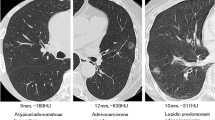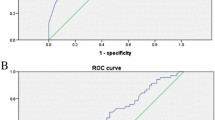Abstract
Purpose
To distinguish between adenocarcinoma in situ (AIS)–minimally invasive adenocarcinoma (MIA) and invasive adenocarcinoma (IAC) showing pure or part-solid ground-glass nodules (GGNs) by high-resolution computed tomography (HRCT) texture analysis.
Materials and methods
This retrospective study included 101 consecutive patients with 115 pure or part-solid GGNs ≤ 3 cm diameter, which were surgically resected and pathologically diagnosed with AIS, MIA, or IAC (48 AIS–MIA and 67 IAC) between April 2011 and March 2015. Each tumor was manually segmented on axial CT images, and the following texture features were calculated: volume, mass, mean CT value, variance, skewness, kurtosis, entropy, uniformity, and percentile CT numbers (10th, 25th, 50th, 75th, 90th, 95th percentiles). The differences between AIS–MIA and IAC were statistically evaluated using univariate, multivariate, and receiver operating characteristic analysis.
Results
Compared with IAC, AIS–MIA had significantly greater skewness, kurtosis, and uniformity, whereas in the other parameters, AIS–MIA demonstrated significantly lower values than those of IAC. Multivariate analysis revealed that independent differentiators were the 90th percentile CT numbers (P < 0.001) and entropy (P = 0.005) with an excellent accuracy (area under the curve, 0.90).
Conclusions
The 90th percentile CT numbers and entropy can accurately distinguish AIS–MIA from IAC.



Similar content being viewed by others
References
Travis WD, Brambilla E, Noguchi M, et al. International Association for the Study of Lung Cancer/American Thoracic Society/European Respiratory Society international multidisciplinary classification of lung adenocarcinoma. J Thorac Oncol. 2011;6(2):244–85.
Travis WD, Brambilla E, Burke AP, Marx A, Nicholson AG. WHO classification of tumours of the lung, pleura, thymus and heart. 4th ed. Lyon: International Agency for Research on Cance; 2015.
Zhang J, Wu J, Tan Q, et al. Why do pathological stage IA lung adenocarcinomas vary from prognosis: a clinicopathologic study of 176 patients with pathological stage IA lung adenocarcinoma based on the IASLC/ATS/ERS classification. J Thorac Oncol. 2013;8:1196–202.
Van Schil PE, Asamura H, Rusch VW, et al. Surgical implications of the new IASLC/ATS/ERS adenocarcinoma classification. Eur Respir J. 2012;39:478–86.
Tsutani Y, Miyata Y, Nakayama H, et al. Appropriate sublobar resection choice for ground glass opacity-dominant clinical stage IA lung adenocarcinoma wedge resection of segmentectomy. Chest. 2014;145:66–71.
Zhang Y, Shen Y, Qiang JW, et al. HRCT features distinguishing pre-invasive from invasive pulmonary adenocarcinomas appearing as ground-glass nodules. Eur Radiol. 2016;26(9):2921–8.
Cohen JG, Reymond E, Lederlin M, et al. Differentiating pre- and minimally invasive from invasive adenocarcinoma using CT-features in persistent pulmonary part-solid nodules in Caucasian patients. Eur J Radiol. 2015;84:738–44.
Lee KH, Goo JM, Park SJ, et al. Correlation between the size of the solid component on thin-section CT and the invasive component on pathology in small lung adenocarcinomas manifesting as ground-glass nodules. J Thorac Oncol. 2014;9:74–82.
Robert JG, Paul EK, Hedvig H, et al. Radiomics: images are more than pictures, they are data. Radiology. 2016;278:563–77.
Miles Kenneth A. How to use CT texture analysis for prognostication of non-small lung cancer. Cancer Imaging. 2016;16:10.
Liu Y, Liu S, Qu F, et al. Tumor heterogeneity assessed by texture analysis on contrast-enhanced CT in lung adenocarcinoma: association with pathologic grade. Oncotarget. 2017;8:53664–74.
Chae HD, Park CM, Park SJ, et al. Computerized texture analysis of persistent part-solid ground-glass nodules: differentiation of preinvasive lesions from invasive pulmonary adenocarcinomas. Radiology. 2014;273:285–93.
Son JY, Lee HY, Lee KS, et al. Quantitative CT analysis of pulmonary ground-glass opacity nodules for the distinction of invasive adenocarcinoma from pre-invasive or minimally invasive adenocarcinoma. PLoS ONE. 2014;9:e104066. https://doi.org/10.1371/journal.pone.0104066.
MacMahon H, Naidich DP, Goo JM, et al. Guidelines for management of incidental pulmonary nodules detected on CT images: from the Fleischner Society 2017. Radiology. 2017;284:1–16.
Rasband WS, ImageJ, US National Institutes of Health, Bethesda, Maryland, USA, http://imagej.nih.gov/ij/. 1997–2012.
Schneider CA, Rasband WS, Eliceiri KW. NIH Image to ImageJ: 25 years of image analysis. Nat Methods. 2012;9:671–5.
Mull RT. Mass estimates by computed tomography: physical density from CT numbers. AJR. 1984;143:1101–4.
Materka A, Strzelecki M. Texture analysis methods—a review. Technical University of Lodz, Institute of Electronics. COST B11 report; 1998.
Landis JR, Koch GG. The measurement of observer agreement for categorical data. Biometrics. 1977;33:159–74.
Park CM, Goo JM, Lee HJ, et al. Nodular ground-glass opacity at thin-section CT: histologic correlation and evaluation of change at follow-up. Radiographics. 2007;27:391–408.
Hwang I, Park CM, Park SJ, et al. Persistent pure ground-glass nodules larger than 5 mm: differentiation of invasive pulmonary adenocarcinomas from preinvasive lesions or minimally invasive adenocarcinomas using texure analysis. Invest Radiol. 2015;50:798–804.
Davnall F, Yip CS, Ljungqvist G, et al. Assessment of tumor heterogeneity: an emerging imaging tool for clinical practice? Insights Imaging. 2012;3:573–89.
Mackin D, Fave X, Zhang L, et al. Measuring CT scanner variability of radiomics features. Invest Radiol. 2015;50:757–65.
Yasaka K, Akai H, Mackin D, et al. Precision of quantitative computed tomography texture analysis using image filtering: a phantom study for scanner variability. Medicine (Baltimore). 2017;96(21):e6993. https://doi.org/10.1097/MD.0000000000006993.
Funding
This work was supported by JSPS KAKENHI grant number JP17K10352.
Author information
Authors and Affiliations
Corresponding author
Ethics declarations
Conflict of interest
The authors declare that they have no conflict of interest.
Ethical statement
An institutional review board approved this retrospective study and waived the requirement for informed consent.
Electronic supplementary material
Below is the link to the electronic supplementary material.
About this article
Cite this article
Yagi, T., Yamazaki, M., Ohashi, R. et al. HRCT texture analysis for pure or part-solid ground-glass nodules: distinguishability of adenocarcinoma in situ or minimally invasive adenocarcinoma from invasive adenocarcinoma. Jpn J Radiol 36, 113–121 (2018). https://doi.org/10.1007/s11604-017-0711-2
Received:
Accepted:
Published:
Issue Date:
DOI: https://doi.org/10.1007/s11604-017-0711-2




